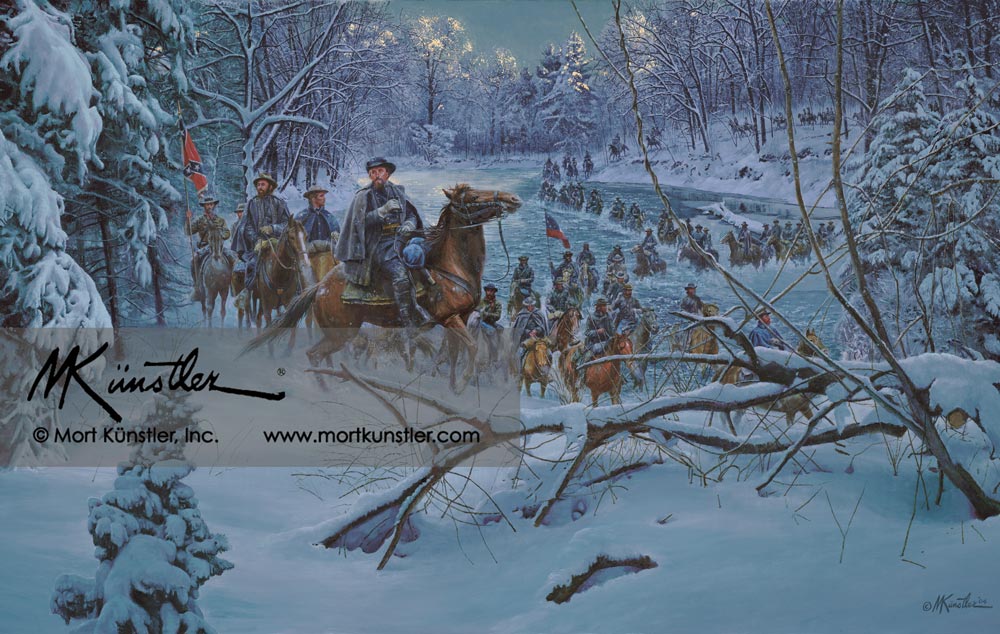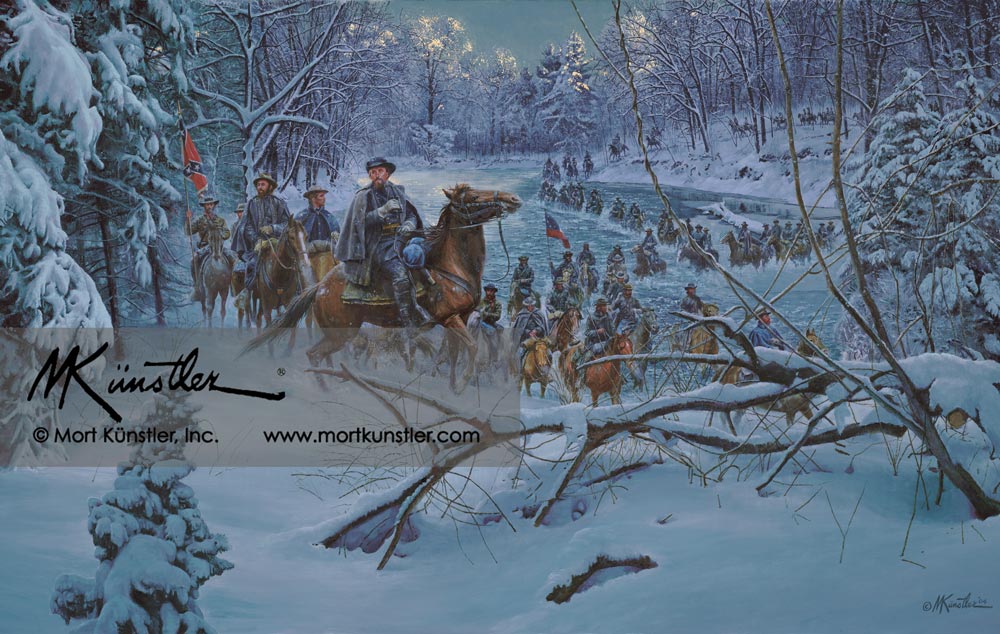The Official Mort Künstler Website
Confederate Crossing - limited edition print
Confederate Crossing - limited edition print
N.B. Forrest at Owen's Ford, Nov. 28, 1864
Couldn't load pickup availability
LIMITED EDITION PRINTS
Paper Prints
Reproduction technique: Fine offset lithography on neutral pH archival quality paper using the finest fade-resistant inks.
Each print is numbered and signed by the artist and accompanied by a Certificate of Authenticity.
Image Size: 17-3/4” x 28” • Overall Size: 23-3/4” x 33”
Signed & Numbered • Edition Size: 950
Signed Artist’s Proof • Edition Size: 100
Giclée Canvas Prints
Reproduction technique: Giclées are printed with the finest archival pigmented inks on canvas.
Each print is numbered and signed by the artist and accompanied by a Certificate of Authenticity.
Classic Edition 21” x 33”
Signed & Numbered • Edition Size: 100
Signed Artist’s Proof • Edition Size: 10
Historical Information
In November of 1864, General William T. Sherman prepared to lead a powerful Northern army in a devastating “March to the Sea” across Georgia. In a desperate attempt to stall Sherman’s campaign, General John Bell Hood led his Confederate army from Georgia back into the heart of Tennessee. Southerners hoped that Hood’s advance would prevent Sherman from ravaging the Deep South – but it was not to be. Northern forces were strong enough to oppose Hood with other armies: Federal troops under General George H. Thomas and John M. Schofield. In late November, Hood attempted to envelop and destroy Schofield’s forces near Spring Hill, Tennessee. Leading the Confederate advance was General Nathan Bedford Forrest’s cavalry, which forded the Duck River on November 28, and spearheaded the attack. They moved their horses through the icy river, looking for battle.
Although unable to affect the campaign’s outcome, Forrest and his Confederate cavalry again set the standard for bold and courageous action. They aggressively engaged the Northern forces before them -- driving back the Northern cavalry, pressing the Federal infantry, and attacking Northern supply trains. Forrest’s success was typical of the fabled “Wizard of the Saddle.”
For untold ages, students of the War Between the States would marvel at Forrest’s tactics and triumphs. Decades after Southern flags were folded and rifles were stacked, former Confederate General Joseph E. Johnston was asked to name the single most successful commander of the Civil War. It had to be Nathan Bedford Forrest, Johnston mused, concluding that had the self-trained Forrest possessed a West Point education, he would have been “the great central figure of the Civil War.”
Mort Künstler’s Comments
For more than ten years, I have wanted to do another painting of Nathan Bedford Forrest, spending much time researching and reading to uncover an event that could be dramatically portrayed on canvas. Some situations are very dramatic but do not lend themselves to creating a good painting. Other events are not necessarily important but work wonderfully to make an exciting picture. Confederate Crossing is one of the latter.
This painting depicts an obscure event that was overshadowed by a giant military campaign. The excellent biography of Forrest, The Confederacy’s Greatest Cavalryman by Brian Steel Wills, follows the famous cavalry commander’s actions. Forrest moved quickly, but he was always alert to danger – and that’s the emotion I hope to convey in this picture. Here Forrest is seen advancing with troops commanded by Colonel Jacob B. Biffle (pictured immediately behind Forrest), as they ford the river. It was undoubtedly a tense moment: Northern forces might have opened fire on them from a riverside ambush. Fortunately for the Southerners, they crossed unopposed – but the day was cold, the snow was thick, and the water was icy.
I positioned the viewpoint of the painting so that the sunlight draws the viewer’s focus to Forrest, emphasizing his prominence. Other elements lead the eye to the center of interest as well, giving depth to the picture. By taking a high viewpoint, I was able to paint a more panoramic vista and get more than sixty horses and riders into the painting. By depicting the last rider coming into the picture in the extreme upper right corner of the painting, I created a sense of flow that hopefully encourages the viewer to feel what it would be like to observe the passing of a large body of cavalry.
I hope this painting of a beautiful landscape conveys the crisp, cold weather, and the difficulties of fording a river in winter-like conditions – elements and actions Americans of the day accepted with routine courage.





